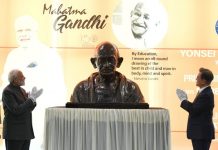Indian artists may not want their art to be weighed on a social justice scale but don’t mind if their actions are, finds Aradhna Wal

IS ART functional or just for art’s sake? The camp lines are redrawn in Mumbai on 5 April, with the opening of the Art for Humanity exhibition. Teesta Setalvad brings together 74 contemporary Indian artists, in the fund raising collaboration by her foundation, Citizens for Justice and Peace (CJP).
CJP’s raison d’etre is championing communal victims, a cause that puts them at odds with political heavyweights. Their ability to ruffle feathers has lost them corporate donors, who prefer to stay away from those imbroglios.
Short on money for her many causes, Setalvad struck upon art as a solution. “The obstacles we face are mainly political. In artists we found natural allies. People unafraid to ideologically challenge the powers that be”, says the 50-year-old activist. “Communalism is like racism. It’s a fight against the demons within us. Not everyone is strong enough to face them. Artists are.”
The seed for this exhibition was planted in 2008 when CJP successfully held an art auction fundraiser. The positive response led CJP to reconfigure their auction, with an eye to also remunerating the artists for their work. A few artists such as Jitish Kallat, Rajan Krishnan and Viveek Sharma have even created works especially for this exhibition.
Art for Humanity is a collaborative platform where both the artist and the initiative get a percentage of the sales. An arrangement photographer Ram Rahman finds extremely equitable: “People constantly ask artists for donations, without realising they too have to pay bills. However, there is strong support and commitment from the artist community for these causes.”
The deterrents for other types of sponsors do not factor here. Rahman explains that artists naturally need to express themselves and fear would make that redundant. Art and justice, he feels, are a natural corollary. “The subject of a work need not be directly political. A Ram Kumar (Delhi-based artist) piece might be a simple landscape, without any bearing on CJP’s cause. It is the act of participation that counts.”
His own contribution captures the Muslim community during Ramzaan, in Old Delhi’s Matya Mahal. While Setalvad sees the connection to a minority community, Rahman himself says it has a “cultural context rather than a political context. Somebody has to like it enough to buy it. Otherwise what is the point?”
Photographer Pablo Bartholomew stresses the futility of seeking a direct connection. “Many times we keep looking for deeper meanings when there aren’t any. Why does a work have to correspond to the cause? It has to sell, so that it raises the needed funds. I sent in Mosque in Pydhonie because it has sold well in the past and will hopefully do so again.”
Preserving the integrity of the subject is a major concern. According to art critic Meera Menezes, there is a long-standing tradition of artists supporting social causes, be it Shireen Gandhy raising funds for flood victims in Pakistan or SAHMAT dedicating years to creating social awareness. It has proven to be an effective tool to raise much needed concern. However, as generous as artists have been, it is not necessary that their work must carry political overtones. Sensitivity to social upheaval and support is reflected equally in their actions.
Art critic Maya Kóvskaya backs Menezes and Bartholomew on this, saying, “Using art as a direct ideological vehicle often makes for heavy-handed, ham-fisted art, and thus also fails to produce an effective polemic.”
In India, where other avenues of outreach for causes of social justice are often closed, there is consensus on the old art as utilitarian debate. The verdict is unanimous. “Artists and photographers are a more liberal lot. They may not be overtly political but they do take a stand,” concludes Bartholomew.
Aradhna Wal is a Trainee, Features with Tehelka.
aradhna@tehelka.com













